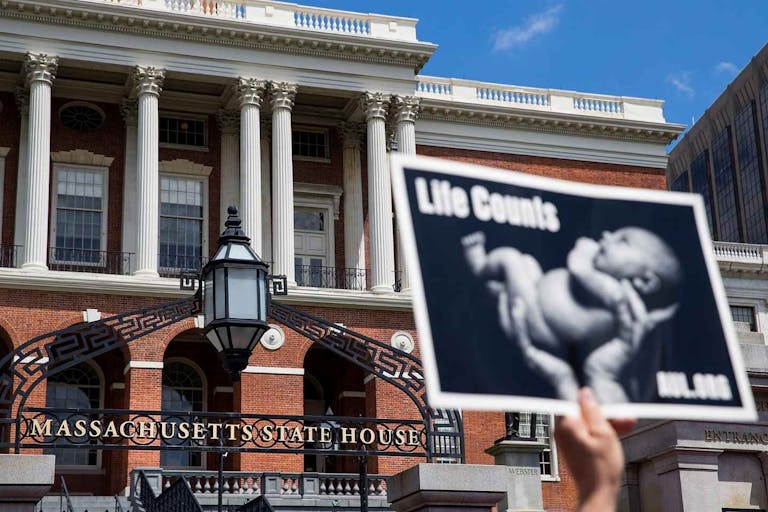
Massachusetts Health Department wants primary care to include abortion
Cassy Cooke
·
The case against Roe v. Wade and Planned Parenthood v. Casey
ROE v. WADE
On January 22, 1973, the Supreme Court handed down its decision in Roe v. Wade. That same day, the Court also decided Doe v. Bolton. In Roe, the Court struck down a Texas abortion law. In Doe, the Court threw out the restrictions on abortion in a more liberal Georgia law. The combined result overturned the laws that restricted abortion in every state.
In Roe, the Supreme Court adopted a trimester framework for state regulation of abortion. The Court held: in the first trimester of pregnancy, states may not regulate abortion; in the second trimester, states may regulate abortion only in ways related to protecting the mother’s health; and in the
third trimester, states may “regulate, and even proscribe, abortion except where necessary, in appropriate medical judgment, for the preservation of the life or health of the mother.” But the language that seemed to allow a third trimester ban on abortion was deceptive, because in Doe, the Court gave “health” such a broad definition that states have been prevented from successfully imposing bans on abortion, including late-term abortions.
The Supreme Court ruled that a restriction on abortion is a violation of the Due Process Clause of the Fourteenth Amendment, which protects the right to privacy. Delivering the Court’s opinion in Roe, Justice Blackmun wrote, “This right of privacy … founded in the Fourteenth Amendment’s concept of personal liberty and restrictions upon state action … is broad enough to encompass a woman’s decision whether or not to terminate her pregnancy.”
Even pro-abortion proponents admit that Roe is intellectually indefensible. Edward Lazarus, a former clerk to Blackmun, wrote, “What, exactly, is the problem with Roe? The problem, I believe, is that it has little connection to the Constitutional right it purportedly interpreted. A constitutional right to privacy broad enough to include abortion has no meaningful foundation in constitutional text, history, or precedent.”
Blackmun claimed that a fetus isn’t a person within the language and meaning of the Fourteenth Amendment. He noted that “the Constitution does not define ‘person’ in so many words.” The word “has application only postnatally.” He observed that state laws restricting abortion “are not of ancient or even of common-law origin.” The laws derive from changes “in the latter half of the nineteenth century.” So, the word person as used in the Fourteenth Amendment “does not include the unborn.”
Each of these arguments falls apart under scrutiny. First, the Constitution doesn’t define person, but the Constitution doesn’t define privacy either. The Supreme Court applied a double standard in Roe, arbitrarily giving the word person a narrow definition and the word privacy a broad definition in order to rationalize its decision to legalize abortion-on-demand. Second, if a fetus isn’t a person because the provisions of the Constitution don’t apply to a fetus, then infants aren’t persons either, because the provisions also don’t apply to infants. Or adolescents in some instances. Third, it’s irrelevant if state abortion laws were less restrictive in the past. Many laws were less restrictive in the past. And it’s irrelevant if state abortion laws originate from statutes not common-law. Many laws originate from statutes. Fourth, when the Fourteenth Amendment was adopted in 1868, abortion was already restricted by at least 36 laws enacted by state or territorial legislatures, including the very Texas law the Supreme Court struck down in Roe. Or in other words, state or territorial laws restricting abortion were already recognized when the Fourteenth Amendment was adopted: the Amendment wasn’t intended to overturn laws restricting abortion. Clearly, the Fourteenth Amendment has always included the “unborn” as “persons” entitled to Constitutional protection.
Despite the evidence, Blackmun ruled otherwise. Further, he claimed the state laws that restricted abortion were inconsistent with the position that a fetus is entitled to Fourteenth Amendment protection as a person. He challenged three features of the state laws: the exceptions allowing for abortion to save the mother’s life; the lack of penalties for the woman with respect to an abortion; and the difference in penalties for abortion compared to murder. If the fetus is a person, he argued, the state laws shouldn’t contain these features.
Blackmun overlooked the obvious. First, the Supreme Court accepts that the Fourteenth Amendment protects the right to life of an adult while also accepting that a right to take the life of an adult in self-defense exists. The same principle applies to a mother if the fetus is posing an imminent, physical threat to her life. Abortion laws, including the Texas law, simply recognized this accepted principle. Second, the lack of penalties for a pregnant woman reflect the widely-held view that a pregnant woman is also a victim of those who are willing to perform abortions and take advantage of her vulnerable situation. Third, the penalty for killing an infant in some states is also less than the penalty for murder, but the Supreme Court hasn’t legalized infanticide.
After deciding that a fetus isn’t a person, Blackmun dodged the main issue of Roe by claiming, “We need not resolve the difficult question of when life begins. When those trained in the respective disciplines of medicine, philosophy, and theology are unable to arrive at any consensus, the judiciary, at this point in the development of man’s knowledge, is not in a position to speculate as to the answer.”
What Blackmun didn’t disclose was that the Supreme Court knew the answer. The Court deliberately ignored the facts and misled the public. First, the question of when human life begins is neither one of philosophy nor theology; the question is one of science. Second, the medical community had already arrived at the consensus that human life begins at conception. In October 1971, a group of medical experts filed a brief of amicus curiae (advice to a court from a person or persons not a party to the case) to the Supreme Court. The brief showed conclusively that science (embryology, fetology, genetics, perinatology, all of biology) establishes that human life begins at conception. And not a single person or group refuted the brief.
Instead of reviewing the scientific facts, though, Blackmun undertook perhaps the most disingenuous endeavor of any Supreme Court Justice ever when delivering an opinion. He used nearly 4,000 words to review the history of human thought, informing the public that, among other things, the ancient Greeks and Romans didn’t offer much opposition to abortion. Blackmun failed to mention that, while permitting abortion, the ancient Greeks and Romans also engaged in human sacrifices, but in his defense, he probably wasn’t implying that we should also permit that practice today. Just abortion.
Because a fetus, Blackmun decided, is merely a “potential life.” But, while the states can’t override a woman’s “right to terminate her pregnancy,” the states have an “important and legitimate interest” in protecting the potential life, he ruled. This interest reaches a “compelling” point at viability, which is when “the fetus then presumably has the capability of meaningful life outside the mother’s womb.”
Blackmun’s argument is illogical and unjustifiable. A fetus inside the womb and an infant outside the womb are both still completely dependent on others for survival. The claim that one has the capability of meaningful life and the other doesn’t has no medical or legal basis.
In summary, Blackburn concluded that “the abortion decision in all its aspects is inherently, and primarily, a medical decision, and basic responsibility for it must rest with the physician.” Wrong. Abortion “in all its aspects” is the intentional killing of innocent human life, which isn’t a medical decision. And responsibility for it rests with the government, not the physician.
PLANNED PARENTHOOD v. CASEY
In Planned Parenthood v. Casey, the Supreme Court considered a Pennsylvania law that imposed regulations on abortion. The law included certain information requirements, a parental consent requirement, a judicial bypass procedure for parental consent, a husband notification requirement, notification exceptions, a medical emergency definition, and reporting requirements for abortion providers. On June 29, 1992, the Court’s opinion was delivered by Justice O’Connor, Justice Kennedy, and Justice Souter, joined in parts by Justice Stevens and Justice Blackmun.
While Roe v. Wade wasn’t directly connected to the Pennsylvania law, which didn’t prohibit abortion, the Supreme Court ruled that “Roe’s essential holding be retained and reaffirmed.”
The Court noted, “Liberty finds no refuge in a jurisprudence of doubt. Yet, 19 years after our holding that the Constitution protects a woman’s right to terminate her pregnancy in its early stages, Roe v. Wade, 410 U.S. 113 (1973), that definition of liberty is still questioned.” But it’s the Court’s definition, or lack of a definition, for human life, and the Court’s refusal to protect human life, that’s still questioned. And the illogical, unjustifiable arguments the Court made attempting to justify its holding in Roe serve only to intensify the opposition.
Defending its decision in Roe, the Supreme Court argued that “the adjudication of substantive due process claims may require this Court to exercise its reasoned judgment in determining the boundaries between the individual’s liberty and the demands of organized society.”
But as Justice Scalia noted, in dissent, the Court didn’t “contend that Roe v. Wade was a correct application of ‘reasoned judgment’; merely that it must be followed, because of stare decisis [the legal principle of following precedent].” And once again, the Court misrepresented the issue, because it’s life, and not the demands of organized society, for which boundaries with individual liberty must be determined.
The Court argued, “Constitutional protection of the woman’s decision to terminate her pregnancy derives from the Due Process Clause of the Fourteenth Amendment. It declares that no State shall ‘deprive any person of life, liberty, or property, without due process of law.’ The controlling word in the cases before us is ‘liberty.’” Actually, no. The controlling words are “life” and “liberty.”
Article continues below
Dear Reader,
Have you ever wanted to share the miracle of human development with little ones? Live Action is proud to present the "Baby Olivia" board book, which presents the content of Live Action's "Baby Olivia" fetal development video in a fun, new format. It's perfect for helping little minds understand the complex and beautiful process of human development in the womb.
Receive our brand new Baby Olivia board book when you give a one-time gift of $30 or more (or begin a new monthly gift of $15 or more).
Continuing with the liberty argument, the Court claimed, “Our obligation is to define the liberty of all, not to mandate our own moral code. The underlying constitutional issue is whether the State can resolve these philosophic questions in such a definitive way that a woman lacks all choice in the matter.”
First, the Court’s obligation is also to define life for all, an obligation the Court failed to fulfill. Second, the Court masterfully slipped morality and philosophy into the issue to avoid facing the facts: the scientific facts that establish a human fetus is a human life, and the legal facts that show a fetus is a person entitled to Fourteenth Amendment protection.
On the defensive, the Court escaped into an ideological fantasy world. “At the heart of liberty is the right to define one’s own concept of existence, of meaning, of the universe, and of the mystery of human life,” the Court claimed. “Beliefs about these matters could not define the attributes of personhood were they formed under compulsion of the State.”
Again, the Constitution protects life as well as liberty. How can the Supreme Court uphold the Constitution and protect life after it has given away the “right to define” life? But that was the whole point.
The Court then alleged that by restricting abortion, the states were imposing their “own vision of the woman’s role” in society. Questioning others’ motives is a favorite tactic of pro-abortion proponents. The allegation, though, is unfounded. A state restricts abortion to protect life.
After considerable effort spent evading the main issue of Roe, life, the Court restated, “Application of the doctrine of stare decisis confirms that Roe’s essential holding should be reaffirmed.” But as Chief Justice Rehnquist noted, in dissent, the Court didn’t claim that Roe was a correct interpretation of the Constitution. And the doctrine of stare decisis doesn’t require that a new case adopt the same incorrect interpretation of the Constitution as the original case.
The Court added, “Although Roe has engendered opposition, it has in no sense proven unworkable.” This is the one point the Court made in either Casey or Roe that actually was true. But while it was true at the time Casey was decided in 1992, it’s not true now. In the first half of 2011 alone, hundreds of new laws restricting abortion, dozens in direct conflict with Roe, have been introduced in state legislatures, and many have been passed.
Next, the Court tried again to justify its decision to follow precedent, resorting to a flimsy reliance argument, speculating that “for two decades of economic and social developments, [people] have organized intimate relationships and made choices that define their views of themselves and their places in society, in reliance on the availability of abortion in the event that contraception should fail.” And, “The ability of women to participate equally in the economic and social life of the Nation has been facilitated by their ability to control their reproductive lives.”
While pro-abortion proponents like to claim that all women, or half of the population, would be adversely impacted by overruling Roe, the reality is that, at most, only 25% of the population is female and in childbearing years, and of that group, approximately 60% believe abortion should be illegal in all circumstances or legal in only a few circumstances. And the suggestion that women owe their current success in society to abortion as opposed to their determination, hard work, and skill is highly suspect.
Chief Justice Rehnquist exposed the error of upholding a decision on the grounds of reliance. He wrote that “at various points in the past, the same could have been said about this Court’s erroneous [decision] that the Constitution allowed ‘separate but equal’ treatment of minorities.” He concluded that “the ‘separate but equal’ doctrine lasted 58 years” but “the simple fact that a generation or more had grown used to [that] major [decision] did not prevent the Court from correcting its [error] in [that case]” and it shouldn’t prevent the Court “from correctly interpreting the Constitution here.” But it did.
The Court’s contempt for the truth was striking. Since 1973, the Court had refused to overrule Roe’s essential holding, thus preventing any subsequent constitutional developments to Roe’s central rule. Then in 1992, when deciding Casey, the Court had the gall to rule that Roe wasn’t in jeopardy because subsequent constitutional developments hadn’t disturbed or threatened to diminish the liberty recognized in Roe.
The Court explained, “No change in Roe’s factual underpinning has left its central holding obsolete, and none supports an argument for its overruling.” But the Court in Roe deliberately ignored the scientific facts that establish human life begins at conception. Roe’s “factual underpinning” isn’t factual. Roe was constructed on errors in reasoning, false claims, deception, and the deliberate omission of facts; facts that prove Roe’s central holding is invalid.
The Court then went from defensive to desperate, asserting, “A decision to overrule Roe’s essential holding under the existing circumstances would address error, if error there was, at the cost of both profound and unnecessary damage to the Court’s legitimacy and to the Nation’s commitment to the rule of law.” The existing circumstances were the public opposition to Roe, and the “efforts to overturn it and to thwart its implementation.” Overruling Roe’s central holding, therefore, would appear to be “a surrender to political pressure and an unjustified repudiation of the principle on which the Court staked its authority.” The country’s “loss of confidence” in the Court would be underscored if the Court failed “to keep faith with those who support the decision at a cost to themselves.”
The Court insisted that “error” wasn’t enough of a reason to overrule Roe, because of the “damage” overruling would cause. But the damage caused by not overruling is over a million innocent human lives killed each year. And it’s stubbornly upholding Roe with illogical, unjustifiable excuses that erodes the Court’s legitimacy and the Nation’s commitment to the rule of law.
In a display of extreme arrogance, the Court then declared, “Where, in the performance of its judicial duties, the Court decides a case in such a way as to resolve the sort of intensely divisive controversy reflected in Roe and those rare, comparable cases, its decision has a dimension that the resolution of the normal case does not carry. It is the dimension present whenever the Court’s interpretation of the Constitution calls the contending sides of a national controversy to end their national division by accepting a common mandate rooted in the Constitution.”
The Court dictatorially assumed the authority to call an end to political debate. The Court just couldn’t accept that, despite its opinion in Roe, the pro-life movement wouldn’t accept its interpretation of the Constitution and go away.
Finally, after lecturing about the necessity of following precedent to protect the Court’s legitimacy, the Court then abandoned precedent, rejecting Roe’s trimester framework for evaluating state regulation of abortion, and used the undue burden standard. The Court ruled, “An undue burden exists, and therefore a provision of law is invalid, if its purpose or effect is to place substantial obstacles in the path of a woman seeking an abortion before the fetus attains viability.”
THE SUPREME COURT
Roe v. Wade and Planned Parenthood v. Casey both will be reversed. On what grounds, to what extent, and when are the questions still unanswered. The three most likely scenarios are: Roe and Casey will be reversed not in one decision but over the course of several cases in which the Supreme Court repeatedly upholds increased state restrictions on abortion; Roe and Casey will be reversed in one decision without the Court ruling that a fetus is a person; or Roe and Casey will be reversed in one decision with the Court ruling that a fetus is a person.
A case must be “overruled on the basis of facts, or an understanding of facts, changed from those which furnished the claimed justifications for the earlier constitutional resolutions,” the Court ruled in Casey. And the overruling decision must be “comprehensible to the Nation, and defensible, as the Court’s [response] to changed circumstances.” Applying the Court’s own standards, both Roe and Casey must be overruled.
Every argument made by the Supreme Court when deciding Roe and Casey has been refuted, thus demonstrating a changed understanding of facts. The facts prove that human life begins at conception, and that a fetus is a person within the language and meaning of the Fourteenth Amendment. So a decision to overrule Roe and Casey would easily be comprehensible, and defensible.
Of the Court’s nine Justices, though, four won’t overrule Roe or Casey for any reason, while two (Scalia and Thomas) will overrule Roe and Casey and send the issue back to the states, and it’s believed two others (Roberts and Alito) will also overrule Roe and Casey. The other Justice (Kennedy) was part of the Casey decision, which strongly suggests that he won’t overrule either Roe or Casey, but it’s believed new arguments might have an influence on him partly because of his more recent opinions in other abortion-related cases.
Whether Roe and Casey are challenged before the Justices of this Court, or a future Court, will influence the strategy employed by those arguing the case. The beliefs of the individual Justices are, unfortunately, as important as the Constitution, the law, and the facts. But the next time an abortion case comes before the Supreme Court, the Court will be forced to accept the facts and overrule Roe and Casey, or deny the facts in full public view, exposing its own bias and damaging its own legitimacy, while setting the stage for greater public opposition and further defiance from state legislatures. Either way, the days of abortion-on-demand are nearing an end.
Live Action News is pro-life news and commentary from a pro-life perspective.
Contact editor@liveaction.org for questions, corrections, or if you are seeking permission to reprint any Live Action News content.
Guest Articles: To submit a guest article to Live Action News, email editor@liveaction.org with an attached Word document of 800-1000 words. Please also attach any photos relevant to your submission if applicable. If your submission is accepted for publication, you will be notified within three weeks. Guest articles are not compensated (see our Open License Agreement). Thank you for your interest in Live Action News!

Cassy Cooke
·
Guest Column
Emily Berning
·
Opinion
Nancy Flanders
·
Opinion
Mark Wiltz
·
Opinion
Mark Wiltz
·
Pop Culture
Madison Evans
·
Media
Paul Pauker
·
Analysis
Paul Pauker
·
Opinion
Paul Pauker
·
Opinion
Paul Pauker
·
Media
Paul Pauker
·